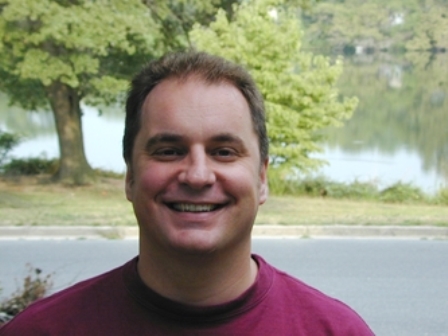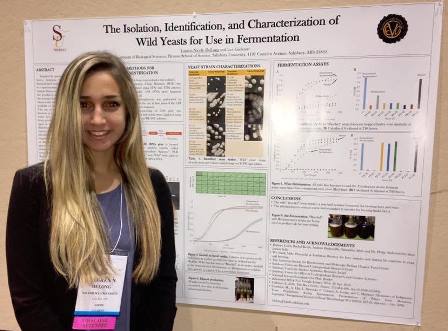Breweries Tap Into SU's Expertise
 SALISBURY, MD — “Cheers.” That’s how Bryan Brushmiller ends an email. Fan of the television show? Maybe. The more likely explanation: Craft brewing is in Brushmiller’s DNA. And when the Burley Oak Brewing Company founder, who graduated from Salisbury University in 2000 with a B.S. in biology, wants to know what’s in his beers’ DNA, he calls upon his Alma Mater to get the job done.
SALISBURY, MD — “Cheers.” That’s how Bryan Brushmiller ends an email. Fan of the television show? Maybe. The more likely explanation: Craft brewing is in Brushmiller’s DNA. And when the Burley Oak Brewing Company founder, who graduated from Salisbury University in 2000 with a B.S. in biology, wants to know what’s in his beers’ DNA, he calls upon his Alma Mater to get the job done.
In particular, a microscopic job involving fungus … and getting funky (more on that later).
“I had heard about some research that had been done on yeast because of my connection with SU and some earlier work I did with Les,” Brushmiller said of Dr. F. Les Erickson, chair of SU’s Biological Sciences Department. “So I reached out again and we started this wild yeast project that I am super excited about.”
The ingredients of beer are fairly straightforward: Malted grains, hops, water and the tiny wild card, yeast, which converts carbohydrates into alcohol, so it’s essential in any recipe that calls for fermentation. Different types of yeast can produce different tastes, so it’s important to know which one is being used. But with more than 1,500 species, that can be a challenge.
Meeting that challenge is how Erickson and his students got involved in the beer business. Their ability to examine the DNA of different yeasts is helping Burley Oak, of Berlin, MD, and Salisbury’s Evolution Craft Brewing Company (Evo, as it’s commonly known) create consistent recipes, ensuring that the right strain of yeast is used to produce the flavors and aromas they are striving for.
What they are increasingly after — for illustrative purposes, just explore the aisles of SU-adjacent Cheers!, where Brushmiller used to worked, or any other bottle shop — are tongue-tantalizing ales, pilsners, porters and hopped-up IPAs that are described, in industry-speak, as wild, sour and funky, a term that gave rise to Brushmiller’s Funk Factory. It’s where he does his experimentation, Mr. Budweiser becomes indignant, and Mrs. Coors clutches her pearls and swoons. SU scientists, though, are more than happy to help.
“As a molecular biologist who uses yeast both in the lab to study genes and at home to make beer and wine, working with Burley Oak and Evo on these wild-yeast projects is a natural fit,” Erickson said. “Plus, my students learn molecular lab techniques and present their research at national science conferences, so these collaborations help promote science, education and local beer at the same time.”
Erickson and lead researcher Allison Brown, who graduated from SU in 2017 with a B.S. in biology and works for EAG Laboratories in Easton, MD, helped Burley Oak identify and isolate microorganisms present in its open-fermented beers. They tested “Just the Tip,” a Kölsch-style ale, and “Coolship Sour Sauce,” an ale that involves aging in wine barrels.
“We love the ability to utilize all the fun lab equipment and talent that SU has,” Brushmiller said.
Using PCR (polymerase chain reaction) amplification and DNA sequencing, then comparing the results to an online database of known yeast species (the entire process is referred to as DNA fingerprinting), they were able to identify Saccharomyces cerevisiae, which is commercially available and is the most common yeast found in ales. It is the Cheers bar-crowd-yells “Norm!” of the yeast world. A bit predictable. Brushmiller doesn’t want the norm. More interestingly, Erickson and Brown identified Pichia kudriavzevii, a yeast that has been found in spontaneously fermented wines. The bar crowd yells, “Bingo!”
“This yeast will be propagated in-house and will be a beer that will be replicated and brewed again,” Brushmiller said. “We are also going to have this yeast available to all other Eastern Shore breweries to use and brew with.”
It’s a collaborative community, and a potential destination for the yeast is Evo, which worked with Erickson and lead researcher Lauren  DeLong, an SU biology major, on finding unique strains of wild yeasts from the local environment that can be domesticated for craft brewers. They tested — again using DNA fingerprinting — wild and cultivated fruits growing in the area and a Belgian-style ale being aged in wine barrels.
DeLong, an SU biology major, on finding unique strains of wild yeasts from the local environment that can be domesticated for craft brewers. They tested — again using DNA fingerprinting — wild and cultivated fruits growing in the area and a Belgian-style ale being aged in wine barrels.
“So far, we've discovered one wild yeast that shows ideal characteristics for brewing, which we named ‘Brachel’ after former students from Dr. Erickson's lab,” said DeLong, of Laurel, MD, who wants to pursue a Ph.D. in molecular biology and become a professor. “In addition, sometimes breweries like Evo will use unidentified strains of yeast, and we provide the service of genetically identifying and characterizing these strains so that they know what they're working with and can continue to brew successful beers in a more formulaic fashion.”
Yeasts of note were Brettanomyces, which was isolated from the wine-barrel ale and has the potential for creating funky beers, and a wild strain of the ubiquitous Saccharomyces cerevisiae — “Norm!” — that produces pleasant, fruity aromas.
“It was exciting to work with Evo because people would really like to listen to me talk about my research,” DeLong said. “I think the typical non-scientist tends to stray away from listening to scientific topics, but I feel like my project helped others realize how cool science can be.”
Brushmiller appreciates everyone’s efforts, but, for him, “the real excitement is to see what the beer tastes like.”
So after all her hard work, DeLong must have “sampled” the fruit of her labor; you know, for science’s sake.
Cheers?
“No!” she said. “I started this research at 18, and I'm only 20 now.”
For more information, call 410-543-6030 or visit the SU website at www.salisbury.edu.
